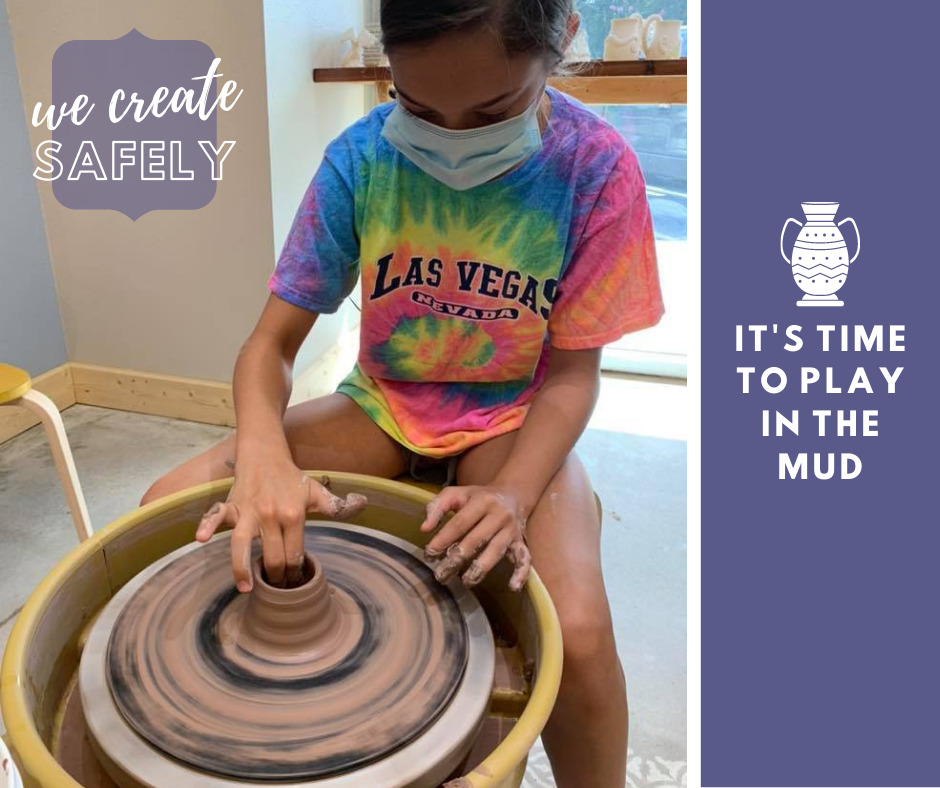
Art for Kids, Part Two: developing their creativity leads to greatness
It’s time to line up some amazing art camps for your children this summer! Studios are taking the necessary precautions to keep your children and their staff safe while they create, socialize and learn! What are the MANY benefits of enrolling your children in art classes? Read on … (and be sure to read our earlier blog with more on the importance of art classes for children).
WHY ENROLL YOUR CHILD IN AN ART PROGRAM?
– ENCOURAGES DISCIPLINE – During art classes, students must exercise discipline while creating and learning about art. Students must pay attention to the instructor, study the technique, follow instructions and take constructive criticism in order to progress as an artist. Art classes lace emphasis on practice, just like any other academic lesson. In order to hone their craft, students must commit to their lessons and even take time out of class to practice.

– DEVELOPS PATIENCE AND FOCUS – Most toddlers have short attention spans. Children aged between 16-19 months are generally able to focus on a task for 2-3 minutes. However, regular drawing activity can help improve a child’s concentration levels and establish the concepts of patience and focus.
Concentrating on the intricacies of drawing is often the first step towards establishing good study habits. Setting aside time in your child’s day to allow her to engage in drawing will aid the development of his/her ability to concentrate on a range of tasks simultaneously. Drawing regularly for a short periods of time is the best way to improve their focus over time. The benefits of art classes are that children get to set aside a specific time to practice their art. As well as being provided with all the necessary materials for their creative needs.
– IMPROVES COMMUNICATION SKILLS – Drawing is an outlet for children who are non-verbal communicators. Even children with a good vocabulary aren’t always able to express their emotional needs. Thus, through drawing, children are able to develop their emotional intelligence in a creative way. Putting color pencils to paper gives children another means of communication – even if their artwork is only really understood by the child themselves in that moment.
– IMPROVES SOCIAL SKILLS – Going hand in hand with improving a child’s communication skills, taking art lessons can also improve a children’s social skills. Children learn best in social environments. Thus, in art classes, the child will make friends with other children in the art class and bond over their shared passion for art. Moreover, creating art as a group is an ideal way of mastering skills while learning from each other. In the act of sharing materials with the rest of the class, children learn to share and help out their peers, further 
– DEVELOPS MOTOR SKILLS – Holding a pencil or other drawing implement helps children develop their hand-eye coordination and fine motor skills. The more practice your child has with making simple marks on paper, the quicker they’ll develop the ability to undertake more advanced activities like coloring and handwriting. At the beginning, this is done most effectively by the repetition of simple patterns. What you tend to see is that children will initially press harder when they’re uncertain of what they’re doing and have less control. With encouragement and step-by-step guidance, it’s possible to improve their skills and build their confidence.
– DEVELOPS SPACIAL AWARENESS – Drawing can help improve a child’s visual analysis and help them understand concepts like distance, space, texture, and size. Such activities can help children understand how objects relate to each other. Which in turn will help them understand more advanced concepts like depth and volume.
Visual analysis is an essential skill for everyday life, which can be learned from a young age through artistic pursuits.
Through art classes, children will learn how to understand and interact with the surrounding environment. They will notice more details about their surroundings, and how those details relate to each other. Children can better understanding of the world around them through art. That attention to detail will spill over into other aspects of their life. Such examples include being more observant. Which will allow them to catch their own mistakes easily and become less careless while doing school work.

– ENCOURAGES INDEPENDENCE – Participating in art classes allow the child some freedom, freedom to be independent and curious. The student has complete control over their artwork and is responsible for the materials, technique and purpose of their work. By taking their project into their own hands, children learn how to care for the materials and how to put them back on their own. Not to mention they are encouraged by art teachers to do what they want and to ask for help only when they need it. This in turn allows them to think for themselves during lesson time and they will be more independent in school and at home.
– DEVELOPS CRITICAL THINKING – The process of observation paves the path to critical thinking. The child who has attended art class would be able to pick up the tiny details that others would not. They see the details most others take for granted, and they become more curious, which leads them to ask questions and find alternate solutions to problems. Students that are taught to examine and consider the details also helps teach students to more closely observe and analyze the world around them—skills that are vital in critical thinking.
– ALLOWS REALISTIC EXPRESSION – Although there is a lot of observational work done in art classes, that observational skill can be applied in the children’s daily lives. Diagrams, maps and graphs can be easily visualized with prior art experience. Students who can draw out anatomical diagrams from their biology textbooks will better understand the functions of that system as a whole. Thus, children will achieve a firmer grasp of the concepts and ideas presented to them. children equipped with artistic knowledge will grow up being able to articulate their ideas in a clear and concise manner. Perhaps after all that observational drawing they did in class, your child could be drawing up building blueprints in no time!

– DEVELOPS OPEN MINDNESS – Since the act of observing art can change our innate ways of thinking and how we see the world, when children learn how to make art of their own, they can achieve that level of open mindedness with time. In addition, children see their peers work and how it vastly differs from their own. Which allows them to be more understand the viewpoints of others at a young age.
– BUILDS CONFIDENCE – Art education allows students to explore and practice with new mediums and techniques, thereby finding their own “voice.” They gain confidence in the path to discovery, without fear of the final outcome. It goes without saying, that having confidence is beneficial for personal and professional relationships. That confidence will help students step out of their comfort zone, be willing to step up as a leader or pursue their dreams.
Drawing and creative skills can be a great asset and will further the development of your child, and the benefits of art classes are too good to pass up!
FIND YOUR LOCAL STUDIO AND INQUIRE ABOUT THEIR SUMMER PROGRAMS FOR KIDS!
Information from this blog is from The Visual Arts Center

